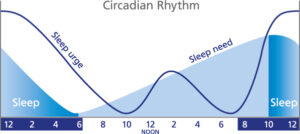There have been some questions and articles regarding recent publications, one article notably from the American Medical Association1, regarding health risks associated with LED lighting. These articles specifically mention outdoor municipal lighting in the form of street lamps.
We should get this out of the way first as to not alarm anybody, “the position of the Illuminating Engineering Society (IES) is that typical exposures to exterior lighting after sunset have not been shown to lead to cancer or other life-threatening conditions”.2 Though light is perceived through your eyes, one can have nonvisual responses from optical radiation. Even blind humans without cones or rods can have nonvisual responses according to research done in 2007.3 “It turns out that mammals have an additional light-sensitive photoreceptor in the retinal ganglion cell layer (pRGCs) that is directly sensitive to light and is primarily responsible for mediating these responses”, the leading researcher on this study states.
The nonvisual response to blue light, typically 4000K and above4, is recognized by the AMA as being harmful and dangerous for the retina, as a result of cellular oxidative stress. Not only that, the Dark-Sky Association (IDA) states that lights above 4000K have a 2.5 fold in lighting pollution. Early designs of LEDs generated a color spectrum with excessive blue wavelength. The short wavelengths of blue light are known to affect the circadian rhythm that regulates your sleep and natural production of melatonin from your pineal gland.
These blue wavelengths do occur naturally from the sun, which is how your body’s sleep cycle is related to the rising and setting of the sun. Being exposed to excessive amounts of artificial blue light after the sun has set has been shown to inhibit release of melatonin which then directly affects your natural sleep cycle and is one of the causes of insomnia1. For people who are light sensitive, low-intensity exposure to blue light over long periods of time, due to cellular oxidative stress, can have the same effect as being exposed to artificial blue wavelengths after the sun has set. These effects are not limited to human-beings either, nocturnal animals as well as plants have been observed exhibiting adverse effects to these same wavelengths.
The older LEDs that are known to cause these effects are being replaced by municipalities after these studies were released. Also as a company who sells LEDs, GenPro has made sure the lights supplied are in accordance with the new standards that replicate moonlight as to not emit the harmful short, blue wavelengths. These lights are specifically emitting a 3000K warm yellowish color that have been known to not have adverse effects on the circadian rhythm. GenPro also believes in the work of the IDA and supply street lamps with proper light shielding to direct light only in the direction needed.
One thing to consider is your cellphone. People have been known to keep their phone screen too bright, which causes strain on the eye. Cellphones also emit the short wavelengths of blue, which is why it is recommended to not use your phone within an hour of going to bed. Most people don’t follow this as they read on their phone while in bed. There are ways around this with apps you can get that filter out the blue light, giving your screen a red tint. These apps can even follow the ever changing sun rise and set times and automatically apply the filter when needed.
GenPro is on the leading edge of technology and researches extensively to find what not only is best for saving the customer the most money but also on what is best for society as a whole. GenPro strives to make informed decisions from experience as well as research to collectively reduce the strain on the environment from CO2 emissions to light pollution.
References:
1) Human and Environmental Effects of Light Emitting Diode (LED) Community Lighting – AMA
2) IES Position Statement (PS‐03‐10) – Effects of Exterior Lighting on Human Health
3) Short-Wavelength Light Sensitivity of Circadian, Pupillary, and Visual Awareness in Humans Lacking an Outer Retina
4) International Dark-Sky Association

